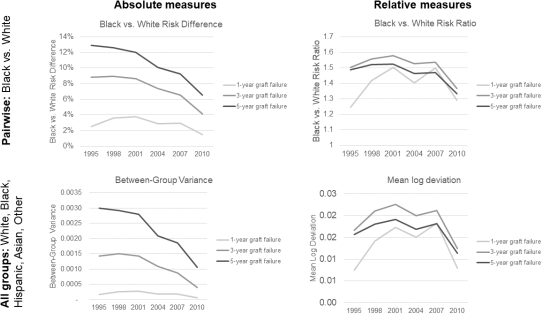Trends of Racial and Education Disparity in Post-Kidney-Transplant Graft Survival and Patient Survival: Do Different Metrics Lead to Different Conclusions?
M. Garber, K. Ross, R. Hamoda, L. Plantinga, R. Patzer.
Emory University, Atlanta.
Meeting: 2018 American Transplant Congress
Abstract number: C295
Keywords: African-American, Graft failure, Psychosocial, Survival
Session Information
Session Name: Poster Session C: Psychosocial and Treatment Adherence
Session Type: Poster Session
Date: Monday, June 4, 2018
Session Time: 6:00pm-7:00pm
 Presentation Time: 6:00pm-7:00pm
Presentation Time: 6:00pm-7:00pm
Location: Hall 4EF
Background: Monitoring trends in racial and socioeconomic disparity in disease outcomes is a Healthy People 2020 priority. For some chronic disease outcomes, such as cancer mortality, the same underlying data has generated different interpretations of trends in disparities depending on the measure used. This may also be true for kidney-transplant outcomes.
Objective: To measure disparities in post-transplant graft survival and patient survival by race and education over time using several pairwise, group, absolute, and relative measures to assess how conclusions on disparity may depend on the measure used.
Methods: Among adult kidney transplant recipients from 1995 and 2012 in the UNOS database, we calculated 1-year, 3-year, and 5-year graft and patient survival using the Kaplan Meier method. For disparities by race, we calculated Between-Group Variance (BGV), an absolute measure, and Mean-Log Deviation, a relative measure, to compare all groups (White, Black, Hispanic, Asian, Other) and risk ratios (RR) and risk differences (RD) comparing blacks with whites.We used Relative and Absolute Concentration Index to compare all education groups (none, some grade school, high school, some college, college, grad school) and RR and RD for pairwise education comparisons.
Results: Absolute measures of racial and education disparity in graft and patient survival were highest for the 1995-1997 cohort for the 3- and 5-year outcomes, while little change occurred for the 1-year outcome (e.g., graft failure by race presented in Figure 1). In contrast, relative measures increased slightly or remained constant throughout the late '90s and early '00s and declined in the late '00s and were generally higher for the 3-year outcome.
In contrast, relative measures increased slightly or remained constant throughout the late '90s and early '00s and declined in the late '00s and were generally higher for the 3-year outcome.
Conclusion: Conclusions differ depending on the measure used. Absolute measures decreased consistently over time, while relative measures increased slightly then decreased at the end of the period. Researchers should consider examining relative measures to highlight disparity regardless of outcome frequency and absolute measures to highlight disparity in context of overall burden.
CITATION INFORMATION: Garber M., Ross K., Hamoda R., Plantinga L., Patzer R. Trends of Racial and Education Disparity in Post-Kidney-Transplant Graft Survival and Patient Survival: Do Different Metrics Lead to Different Conclusions? Am J Transplant. 2017;17 (suppl 3).
To cite this abstract in AMA style:
Garber M, Ross K, Hamoda R, Plantinga L, Patzer R. Trends of Racial and Education Disparity in Post-Kidney-Transplant Graft Survival and Patient Survival: Do Different Metrics Lead to Different Conclusions? [abstract]. https://atcmeetingabstracts.com/abstract/trends-of-racial-and-education-disparity-in-post-kidney-transplant-graft-survival-and-patient-survival-do-different-metrics-lead-to-different-conclusions/. Accessed December 16, 2025.« Back to 2018 American Transplant Congress
